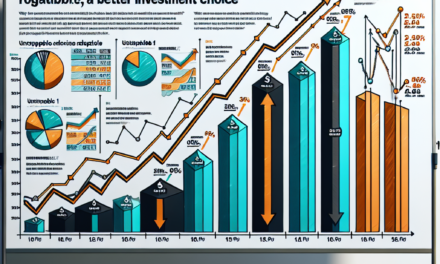“Global Chip Stocks Plummet: $420 Billion Wiped Out After ASML’s Stark Sales Warning”
Introduction
Global chip stocks have experienced a significant downturn, collectively losing $420 billion in market value following a sales warning from ASML Holding NV, a key player in the semiconductor industry. ASML, a leading supplier of photolithography equipment essential for chip manufacturing, issued a cautionary statement regarding its future sales projections, citing potential slowdowns in demand and broader economic uncertainties. This announcement has sent ripples through the semiconductor sector, impacting major chipmakers and related technology companies worldwide. The warning underscores the industry’s vulnerability to shifts in market dynamics and geopolitical tensions, raising concerns about the future growth trajectory of the global semiconductor market.
Impact Of ASML Sales Warning On Global Chip Market
The global semiconductor industry, a cornerstone of modern technology, has recently faced a significant setback following a sales warning from ASML Holding NV, a leading supplier of semiconductor manufacturing equipment. This announcement has sent ripples through the global chip market, resulting in a staggering $420 billion loss in chip stocks. The impact of ASML’s warning is profound, as it underscores the intricate interdependencies within the semiconductor supply chain and highlights the vulnerabilities that can arise from disruptions in key segments of the industry.
ASML, based in the Netherlands, is renowned for its advanced lithography machines, which are essential for producing the latest generation of microchips. These machines are critical for the fabrication of high-performance chips used in a wide array of applications, from consumer electronics to automotive systems and data centers. Therefore, any indication of reduced sales or production capacity from ASML can have far-reaching consequences for the entire semiconductor ecosystem. The company’s recent sales warning has raised concerns about potential slowdowns in chip production, which could exacerbate existing supply chain challenges and lead to increased costs for manufacturers and consumers alike.
The timing of ASML’s announcement is particularly concerning, as the semiconductor industry is already grappling with a series of challenges. The COVID-19 pandemic has disrupted global supply chains, leading to shortages of critical components and materials. Additionally, geopolitical tensions, particularly between the United States and China, have further complicated the landscape, with export restrictions and trade barriers impacting the flow of semiconductor technology and equipment. In this context, ASML’s sales warning adds another layer of uncertainty, prompting investors to reassess their positions in chip stocks and contributing to the significant market sell-off.
Moreover, the implications of ASML’s sales warning extend beyond immediate financial losses. The semiconductor industry is a key driver of innovation and economic growth, powering advancements in artificial intelligence, 5G networks, and the Internet of Things. Any disruption in the supply of cutting-edge chips can hinder technological progress and delay the deployment of next-generation technologies. This, in turn, could have a cascading effect on various sectors that rely on semiconductors, including automotive, telecommunications, and consumer electronics, potentially slowing down the pace of digital transformation across the globe.
In response to these challenges, industry stakeholders are likely to explore strategies to mitigate the impact of ASML’s sales warning. Diversifying supply chains, investing in alternative manufacturing technologies, and fostering international collaboration could be potential avenues to enhance resilience and reduce dependency on single points of failure. Additionally, governments and industry leaders may need to consider policy measures to support the semiconductor sector, such as incentives for domestic manufacturing and research and development initiatives aimed at bolstering technological capabilities.
In conclusion, the $420 billion loss in global chip stocks following ASML’s sales warning serves as a stark reminder of the interconnectedness and fragility of the semiconductor industry. As the world becomes increasingly reliant on digital technologies, ensuring the stability and resilience of the semiconductor supply chain is of paramount importance. By addressing the challenges highlighted by ASML’s announcement, industry stakeholders can work towards a more robust and sustainable future for the global chip market, ultimately benefiting economies and societies worldwide.
Key Factors Behind The $420 Billion Loss In Chip Stocks
The recent announcement by ASML, a leading supplier of semiconductor manufacturing equipment, has sent shockwaves through the global chip industry, resulting in a staggering $420 billion loss in chip stocks. This significant downturn can be attributed to several key factors that have collectively contributed to the market’s reaction. Understanding these elements is crucial for investors and industry stakeholders as they navigate the complexities of the semiconductor sector.
To begin with, ASML’s sales warning has raised concerns about the overall demand for semiconductor manufacturing equipment. ASML, known for its advanced lithography machines essential for producing cutting-edge chips, plays a pivotal role in the semiconductor supply chain. When a company of ASML’s stature issues a sales warning, it signals potential disruptions in the production capabilities of chip manufacturers. This, in turn, can lead to a ripple effect across the industry, affecting companies that rely on these chips for their products.
Moreover, the semiconductor industry is highly sensitive to fluctuations in global economic conditions. The recent sales warning comes at a time when the world is grappling with economic uncertainties, including inflationary pressures, geopolitical tensions, and supply chain disruptions. These factors have already strained the semiconductor supply chain, and ASML’s announcement has exacerbated fears of prolonged challenges. Investors, wary of these uncertainties, have reacted by pulling back from chip stocks, contributing to the substantial market loss.
In addition to economic factors, technological advancements and shifts in consumer demand are also influencing the semiconductor market. The rapid evolution of technology, particularly in areas such as artificial intelligence, 5G, and electric vehicles, has driven an insatiable demand for semiconductors. However, this demand is not uniform across all types of chips. ASML’s warning may indicate a potential mismatch between the types of chips being produced and those in high demand, leading to concerns about inventory imbalances and overproduction in certain segments.
Furthermore, the semiconductor industry is characterized by its cyclical nature, with periods of rapid growth often followed by downturns. The recent boom in chip demand, fueled by the pandemic-induced digital transformation, has led to unprecedented growth in the sector. However, as the world gradually returns to normalcy, there is a natural recalibration occurring in the market. ASML’s sales warning may be a reflection of this cyclical adjustment, prompting investors to reassess their positions in chip stocks.
Another critical factor to consider is the competitive landscape of the semiconductor industry. With numerous players vying for market share, any indication of a slowdown can lead to heightened competition and pricing pressures. ASML’s announcement may have intensified concerns about the ability of companies to maintain their competitive edge in a rapidly evolving market. This has likely contributed to the widespread sell-off in chip stocks as investors anticipate potential challenges in sustaining profitability.
In conclusion, the $420 billion loss in global chip stocks following ASML’s sales warning is a multifaceted issue driven by a combination of economic, technological, and competitive factors. As the semiconductor industry continues to navigate these challenges, stakeholders must remain vigilant and adaptable to the ever-changing landscape. Understanding the underlying causes of this market reaction is essential for making informed decisions and ensuring resilience in the face of uncertainty.
How ASML’s Forecast Affects Semiconductor Industry Trends
The recent announcement by ASML, a leading supplier of semiconductor manufacturing equipment, has sent ripples through the global semiconductor industry, resulting in a staggering $420 billion loss in chip stocks. This development underscores the intricate interdependencies within the semiconductor supply chain and highlights the broader implications for industry trends. ASML’s sales warning, which cited a slowdown in demand for its advanced lithography machines, has raised concerns about the future trajectory of the semiconductor market. As the backbone of modern electronics, semiconductors are integral to a wide array of industries, from consumer electronics to automotive and telecommunications. Therefore, any fluctuations in this sector can have far-reaching consequences.
ASML’s forecast is particularly significant because the company holds a near-monopoly on the production of extreme ultraviolet (EUV) lithography machines, which are essential for manufacturing cutting-edge chips. These machines enable the production of smaller, more powerful, and energy-efficient semiconductors, which are crucial for the advancement of technologies such as artificial intelligence, 5G, and autonomous vehicles. Consequently, a slowdown in ASML’s sales could signal a broader deceleration in technological innovation and adoption. This potential deceleration is further compounded by existing challenges in the semiconductor industry, such as supply chain disruptions and geopolitical tensions. The COVID-19 pandemic exposed vulnerabilities in global supply chains, leading to shortages and delays that have yet to be fully resolved. Additionally, ongoing trade disputes and export restrictions have created an uncertain environment for semiconductor companies, making it difficult to predict future demand and investment.
In light of ASML’s warning, industry stakeholders are now grappling with the possibility of a cyclical downturn in the semiconductor market. Historically, the industry has experienced boom-and-bust cycles, driven by fluctuations in demand and rapid technological advancements. While the current situation may not necessarily herald a full-blown downturn, it does prompt a reevaluation of growth projections and investment strategies. Companies may need to adopt a more cautious approach, balancing short-term challenges with long-term opportunities. Moreover, ASML’s announcement has implications for the competitive landscape of the semiconductor industry. As companies reassess their strategies, there may be increased pressure to diversify supply chains and reduce reliance on a single supplier. This could lead to greater investment in alternative technologies and suppliers, potentially reshaping the market dynamics.
Furthermore, the sales warning may accelerate efforts to enhance domestic semiconductor manufacturing capabilities. Governments around the world have recognized the strategic importance of semiconductors and are investing in initiatives to bolster local production. ASML’s forecast could serve as a catalyst for these efforts, as countries seek to mitigate risks associated with global supply chain dependencies. In conclusion, ASML’s sales warning has cast a shadow over the semiconductor industry, prompting concerns about future growth and innovation. While the immediate impact is evident in the significant loss of chip stock value, the long-term implications are still unfolding. As the industry navigates this challenging landscape, it will be crucial for stakeholders to adapt to evolving trends and uncertainties. By fostering resilience and embracing innovation, the semiconductor sector can continue to drive technological progress and support the digital transformation of the global economy.
Investor Reactions To ASML’s Sales Warning

The recent announcement from ASML, a leading supplier of semiconductor manufacturing equipment, has sent ripples through the global financial markets, resulting in a staggering $420 billion loss in chip stocks. This development has left investors grappling with the implications of ASML’s sales warning, which has cast a shadow over the semiconductor industry. As the backbone of modern technology, semiconductors are integral to a wide array of products, from smartphones to automobiles. Therefore, any disruption in this sector can have far-reaching consequences.
ASML’s warning primarily stems from a slowdown in demand for its advanced lithography machines, which are crucial for producing cutting-edge chips. The company cited a combination of factors, including geopolitical tensions, supply chain disruptions, and a cyclical downturn in the semiconductor market. These elements have converged to create an environment of uncertainty, prompting ASML to revise its sales forecasts downward. Consequently, this announcement has triggered a wave of concern among investors, who are now reassessing their positions in semiconductor stocks.
In response to ASML’s sales warning, investors have been quick to react, leading to a significant sell-off in chip stocks. This reaction underscores the sensitivity of the market to any news that could potentially impact the semiconductor supply chain. The $420 billion loss in market value reflects the widespread apprehension about the future growth prospects of the industry. Moreover, this development has prompted analysts to revisit their projections for semiconductor companies, with many downgrading their outlooks in light of the new information.
The impact of ASML’s announcement is not confined to the company alone; it has reverberated across the entire semiconductor sector. Major players such as Intel, TSMC, and Samsung have also experienced declines in their stock prices, as investors brace for potential ripple effects. The interconnected nature of the semiconductor industry means that a slowdown in one segment can have cascading effects throughout the supply chain. This interconnectedness has heightened investor anxiety, as they consider the broader implications of ASML’s sales warning.
Furthermore, the geopolitical landscape has added another layer of complexity to the situation. Ongoing trade tensions between major economies have exacerbated supply chain challenges, making it difficult for companies to secure the necessary components for chip production. This has led to increased volatility in the market, as investors weigh the potential impact of geopolitical developments on the semiconductor industry. In this context, ASML’s sales warning serves as a stark reminder of the vulnerabilities inherent in the global supply chain.
Despite the current challenges, some investors remain cautiously optimistic about the long-term prospects of the semiconductor industry. They argue that the cyclical nature of the market means that downturns are inevitable, but they are often followed by periods of robust growth. Additionally, the increasing demand for advanced technologies, such as artificial intelligence and 5G, is expected to drive future growth in the sector. However, in the short term, the uncertainty surrounding ASML’s sales warning is likely to continue influencing investor sentiment.
In conclusion, ASML’s sales warning has had a profound impact on global chip stocks, resulting in a $420 billion loss in market value. This development has highlighted the vulnerabilities within the semiconductor industry and underscored the importance of closely monitoring geopolitical and supply chain dynamics. As investors navigate this challenging landscape, they must carefully consider both the immediate risks and the long-term opportunities within the sector.
Long-term Implications For Chip Manufacturers Post-ASML Announcement
The recent announcement by ASML, a leading supplier of semiconductor manufacturing equipment, has sent ripples through the global chip industry, resulting in a staggering $420 billion loss in market value for chip stocks. This development has raised significant concerns about the long-term implications for chip manufacturers worldwide. ASML’s warning about a potential slowdown in sales has not only affected its own stock but has also had a cascading effect on the broader semiconductor sector, highlighting the interconnected nature of the industry.
To understand the potential long-term implications, it is essential to consider the pivotal role ASML plays in the semiconductor supply chain. ASML is renowned for its advanced lithography machines, which are crucial for producing cutting-edge chips. These machines enable the miniaturization of transistors, a key factor in enhancing chip performance and efficiency. Consequently, any indication of reduced demand for ASML’s equipment can be interpreted as a signal of broader challenges facing the semiconductor industry.
One of the primary concerns stemming from ASML’s announcement is the potential impact on innovation within the chip manufacturing sector. The semiconductor industry thrives on continuous advancements in technology, driven by the need for faster, smaller, and more efficient chips. A slowdown in ASML’s sales could imply a deceleration in the adoption of next-generation lithography technologies, which are essential for maintaining the industry’s growth trajectory. This, in turn, could hinder the development of new applications and technologies that rely on cutting-edge chips, such as artificial intelligence, 5G, and autonomous vehicles.
Moreover, the announcement has underscored the vulnerability of the semiconductor supply chain to external shocks. The global chip shortage, exacerbated by the COVID-19 pandemic, has already highlighted the fragility of the supply chain. ASML’s warning serves as a reminder that any disruption in the supply of critical equipment can have far-reaching consequences for chip manufacturers. This vulnerability may prompt companies to reassess their supply chain strategies, potentially leading to increased investments in diversifying suppliers and enhancing supply chain resilience.
In addition to supply chain considerations, the financial implications for chip manufacturers cannot be overlooked. The $420 billion loss in market value reflects investor concerns about the future profitability of semiconductor companies. A prolonged slowdown in ASML’s sales could translate into reduced capital expenditures by chip manufacturers, as they may become more cautious about investing in new equipment. This could have a ripple effect on the entire semiconductor ecosystem, affecting not only equipment suppliers but also materials providers and other ancillary industries.
Furthermore, the geopolitical landscape adds another layer of complexity to the situation. The semiconductor industry is at the center of global technological competition, with countries vying for leadership in chip manufacturing. ASML’s announcement may prompt governments to intensify their efforts to bolster domestic semiconductor capabilities, potentially leading to increased government intervention and support for local chip manufacturers. This could reshape the competitive dynamics of the industry, with implications for global supply chains and market access.
In conclusion, ASML’s sales warning has sent shockwaves through the global chip industry, with significant long-term implications for chip manufacturers. The potential slowdown in innovation, supply chain vulnerabilities, financial repercussions, and geopolitical considerations all contribute to a complex and uncertain future for the semiconductor sector. As the industry navigates these challenges, stakeholders will need to adapt and innovate to ensure continued growth and resilience in the face of evolving market dynamics.
Regional Analysis: Which Markets Are Most Affected By The Chip Stock Decline?
The recent announcement by ASML, a leading supplier of semiconductor manufacturing equipment, has sent shockwaves through global financial markets, resulting in a staggering $420 billion loss in chip stocks. This development has raised concerns about the stability of the semiconductor industry, which is a critical component of the global economy. As investors and analysts scramble to assess the implications of ASML’s sales warning, it is essential to examine which regional markets are most affected by this decline in chip stocks.
To begin with, the United States, home to some of the world’s largest semiconductor companies, has felt the brunt of this downturn. Major players such as Intel, NVIDIA, and AMD have seen significant drops in their stock prices, reflecting investor anxiety over potential disruptions in the supply chain and future revenue streams. The U.S. market’s heavy reliance on semiconductor technology for various industries, including consumer electronics, automotive, and telecommunications, exacerbates the impact of this decline. Consequently, the ripple effects are likely to extend beyond the tech sector, potentially affecting broader economic growth.
Transitioning to Asia, the region’s semiconductor powerhouses, including Taiwan and South Korea, are also grappling with the fallout from ASML’s announcement. Taiwan, home to the world’s largest contract chipmaker, TSMC, is particularly vulnerable due to its pivotal role in the global semiconductor supply chain. Any disruptions in chip production or sales can have far-reaching consequences for the country’s economy, which heavily depends on semiconductor exports. Similarly, South Korea, with giants like Samsung and SK Hynix, faces challenges as these companies navigate the uncertainties surrounding future demand and supply constraints. The interconnectedness of these markets means that any adverse developments can quickly spread across the region, affecting not only chip manufacturers but also related industries.
In Europe, the impact of the chip stock decline is somewhat mitigated by the region’s diversified industrial base. However, key players such as ASML itself, along with other semiconductor firms like Infineon Technologies and STMicroelectronics, are not immune to the broader market trends. The European market’s focus on automotive and industrial applications for semiconductors means that any prolonged downturn could have implications for these sectors, potentially slowing down innovation and production.
Moving to China, the world’s largest consumer of semiconductors, the situation is complex. While Chinese tech companies are heavily reliant on imported chips, the government’s push for self-sufficiency in semiconductor manufacturing could provide some insulation from global market fluctuations. However, the immediate impact of the chip stock decline is likely to be felt by Chinese firms that depend on foreign technology and equipment, potentially hindering their growth and competitiveness in the short term.
In conclusion, the $420 billion loss in global chip stocks following ASML’s sales warning has underscored the vulnerability of regional markets to disruptions in the semiconductor industry. The United States, Asia, Europe, and China each face unique challenges as they navigate this turbulent period. While the long-term implications remain uncertain, it is clear that the semiconductor sector’s health is crucial to the stability and growth of the global economy. As such, stakeholders across these regions must remain vigilant and adaptive to mitigate the potential risks associated with this significant market event.
Strategies For Investors Amidst The Global Chip Stock Downturn
The recent announcement by ASML, a leading supplier of semiconductor manufacturing equipment, has sent ripples through the global chip market, resulting in a staggering $420 billion loss in chip stocks. This downturn has left investors grappling with uncertainty and seeking strategies to navigate the volatile landscape. As the semiconductor industry is pivotal to numerous sectors, including technology, automotive, and consumer electronics, understanding the implications of this downturn and identifying potential strategies is crucial for investors aiming to mitigate risks and capitalize on opportunities.
To begin with, the semiconductor industry is inherently cyclical, characterized by periods of rapid growth followed by downturns. The recent warning from ASML about slowing sales growth has amplified concerns about a potential oversupply in the market. This has been exacerbated by geopolitical tensions, supply chain disruptions, and fluctuating demand patterns. Consequently, investors are advised to adopt a cautious approach, focusing on diversification to spread risk across different sectors and geographies. By doing so, they can reduce their exposure to the volatility of the semiconductor market while still maintaining a stake in its long-term growth potential.
Moreover, it is essential for investors to conduct thorough due diligence on individual companies within the semiconductor sector. Not all companies are equally affected by market downturns; some may possess robust fundamentals, strong balance sheets, and innovative product pipelines that position them well for recovery. Therefore, identifying companies with a competitive edge, such as those with advanced technology or strategic partnerships, can provide a buffer against market fluctuations. Additionally, investors should pay close attention to companies’ earnings reports and forward guidance, as these can offer valuable insights into their resilience and adaptability in challenging market conditions.
In addition to company-specific analysis, investors should also consider macroeconomic factors that could influence the semiconductor industry. For instance, government policies aimed at boosting domestic chip production, such as subsidies and tax incentives, could create favorable conditions for certain companies. Similarly, trends in end-user industries, such as the growing demand for electric vehicles and the expansion of 5G networks, may drive demand for specific types of semiconductors. By staying informed about these broader trends, investors can make more informed decisions about where to allocate their resources.
Furthermore, it is important for investors to maintain a long-term perspective. While the current downturn may be unsettling, the semiconductor industry is expected to continue its growth trajectory over the coming years, driven by technological advancements and increasing digitalization. Therefore, investors with a long-term horizon may find opportunities to acquire quality stocks at attractive valuations during periods of market weakness. Patience and discipline are key, as the market may take time to recover, but those who remain committed to their investment strategy are likely to reap the rewards in the future.
In conclusion, the global chip stock downturn following ASML’s sales warning presents both challenges and opportunities for investors. By adopting a diversified approach, conducting thorough research, considering macroeconomic factors, and maintaining a long-term perspective, investors can navigate the current volatility and position themselves for future growth. As the semiconductor industry continues to evolve, staying informed and adaptable will be essential for achieving investment success in this dynamic sector.
Q&A
1. **What caused the decline in global chip stocks?**
The decline was triggered by a sales warning from ASML, a major supplier in the semiconductor industry.
2. **How much market value was lost in global chip stocks?**
Global chip stocks lost approximately $420 billion in market value.
3. **Which company issued the sales warning that affected the chip stocks?**
ASML, a leading supplier of photolithography equipment for the semiconductor industry, issued the sales warning.
4. **What is ASML’s role in the semiconductor industry?**
ASML is a key supplier of photolithography machines, which are essential for manufacturing semiconductor chips.
5. **How did the market react to ASML’s sales warning?**
The market reacted negatively, leading to a significant sell-off in semiconductor stocks globally.
6. **What are the potential implications of ASML’s sales warning for the semiconductor industry?**
The warning suggests potential slowdowns in demand or production, which could impact the broader semiconductor supply chain and market growth.
7. **Which regions or markets were most affected by the decline in chip stocks?**
Major markets with significant semiconductor industries, such as the United States, South Korea, and Taiwan, were among those most affected by the decline.
Conclusion
The recent warning from ASML, a key player in the semiconductor industry, about potential sales declines has triggered a significant market reaction, leading to a $420 billion loss in global chip stocks. This development underscores the sensitivity of the semiconductor market to supply chain forecasts and the pivotal role companies like ASML play in shaping investor sentiment. The substantial market impact reflects broader concerns about the stability and growth prospects of the semiconductor sector, which is crucial for various industries worldwide. As the market adjusts to these warnings, stakeholders will likely focus on strategic responses to mitigate risks and capitalize on emerging opportunities within the evolving technological landscape.





